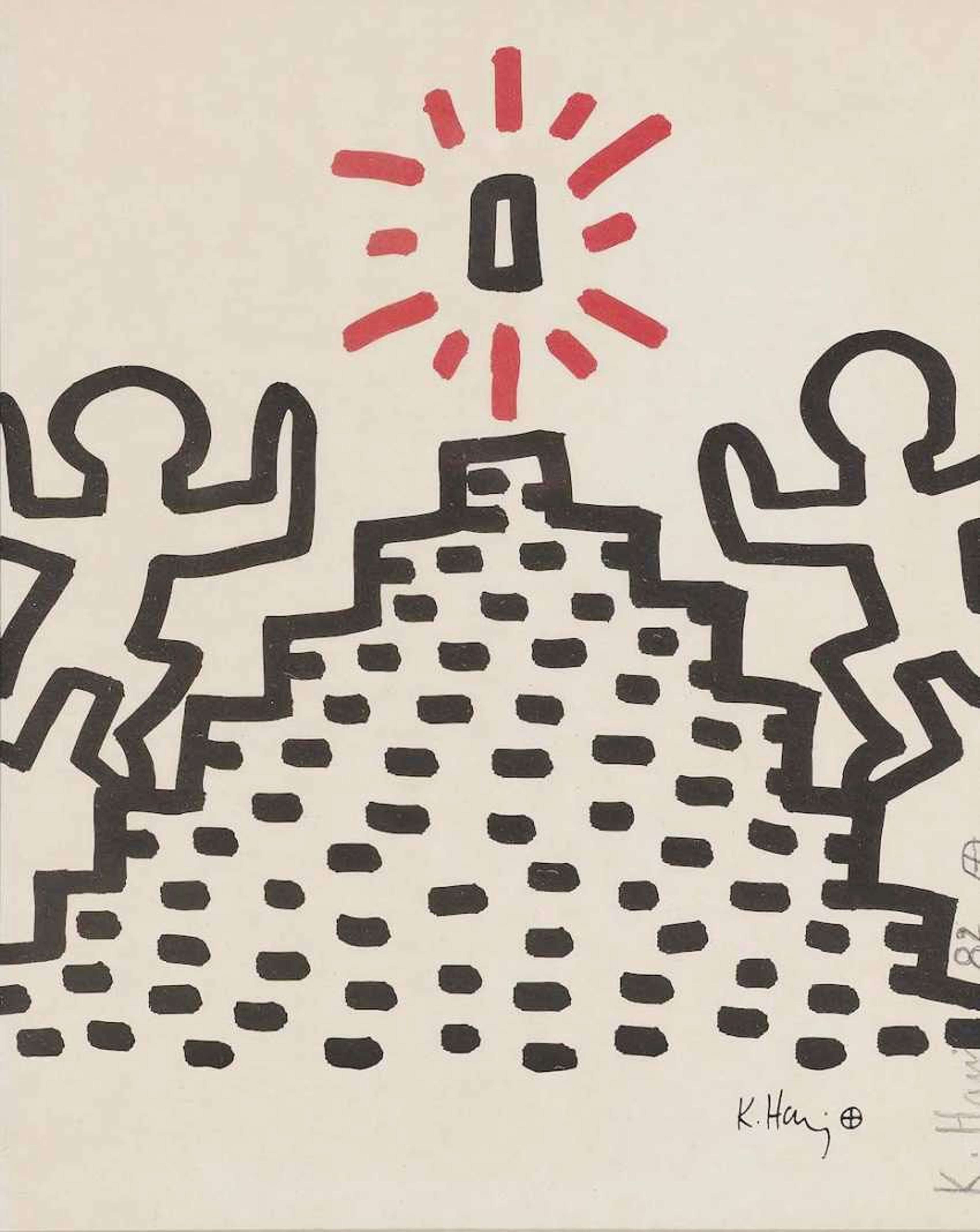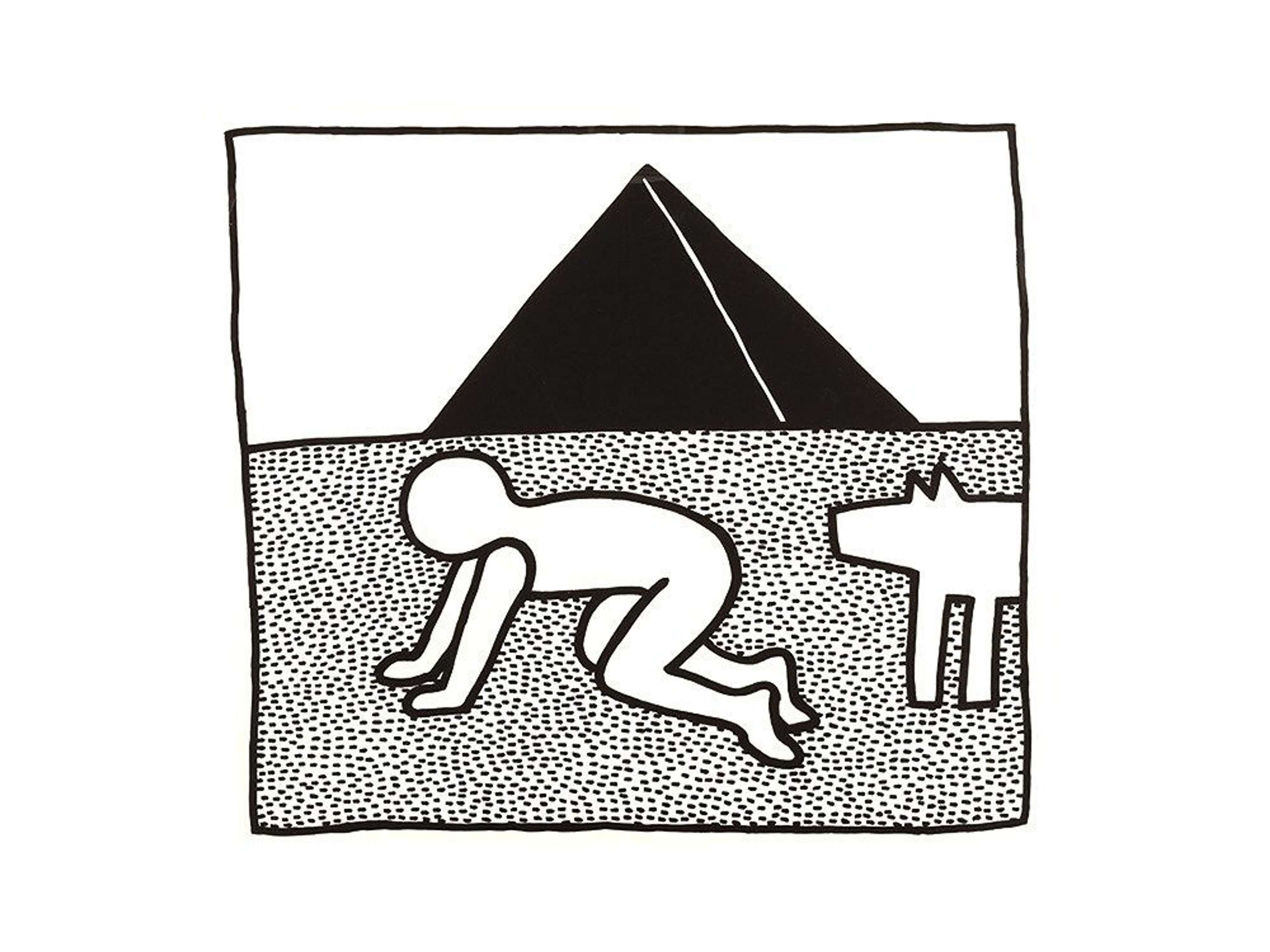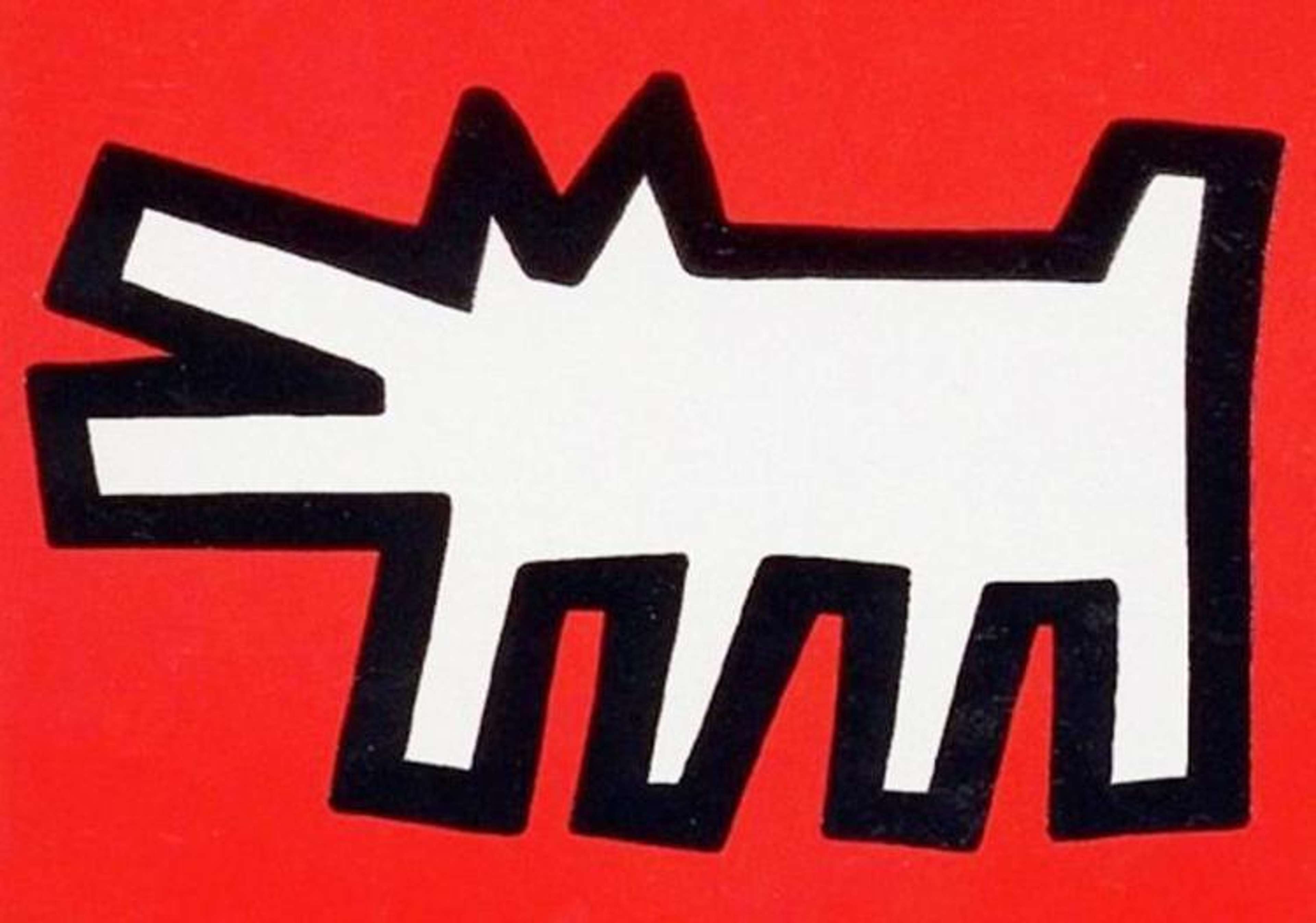 Silence Equals Death © Keith Haring 1989
Silence Equals Death © Keith Haring 1989
Interested in buying or selling
Keith Haring?

Keith Haring
250 works
Keith Haring was perpetually drawn to using Pyramids as an artistic motif throughout his artistic career. Inspired by ancient civilisations and ideas of eternity, Haring sought to create an iconography which would be universally legible, even after his own untimely death.
The pyramid became an empowering symbol for LGBTQ+ communities in Haring's work.
 Pyramid (gold II) © Keith Haring 1989
Pyramid (gold II) © Keith Haring 1989The upside-down pink triangle was a symbol perpetuated by the Nazis to identify and alienate homosexual men. With the organisation ACT UP, who campaigned tirelessly for AIDS visibility, Keith Haring flipped the triangle into one of his pyramids. Populated by his iconic outlined figures, Silence Equals Death uses this pink pyramid as a triumphant symbol. This work, alongside a lot of Haring's later oeuvre, advocated for socio-political action to end the AIDS epidemic once and for all.
The pyramid is an important backdrop for Haring's modern hieroglyphics.
 Bayer Suite 2 © Keith Haring 1982
Bayer Suite 2 © Keith Haring 1982Keith Haring committed himself to creating a universal, visual language in his artwork. By foregrounding the pyramid, Haring revealed his relentless crafting of these modern hieroglyphics. Coupled with his simple outlined figures, Haring created an iconography which is universally legible, regardless of language, class, sexual, and gender barriers.
Haring used the pyramid as the backdrop for some of his most moralistic works.
 Pyramid (blue I) © Keith Haring 1989
Pyramid (blue I) © Keith Haring 1989Haring's outlined figures are famously gender-less, race-less, and class-less, making them instantly relatable. Thanks to this, his artwork represented the many strengths and the many pitfalls of humanity. In Pyramid (gold) and Pyramid (blue), Haring represents the vices and virtues of mankind, respectfully. The entire pyramid is filled with a flurry of Haring's archetypal figures, conveying powerful moral stories to the viewer through images alone.
The Pyramids are a powerful metaphor for civilisation and the resilience of mankind.
 Fertility 2 © Keith Haring 1983
Fertility 2 © Keith Haring 1983Perpetually inspired by the long-standing pyramids of Ancient Egypt, Haring's Pyramids are testament to the resilience of human invention. The pyramid became a particularly important motif in Haring's Fertility Suite series, which challenged the injustices of racism and the horror of HIV/AIDS in the 1980s. Fertility 2 takes a spotted pyramid as its focal point, which is under attack by two UFOs. In spite of this the pyramid remains in tact, speaking to the strength of people affected by the AIDS epidemic.
Haring's Pyramids are a testament to his interest in ancient civilisations.
 Image © Hrag Vartanian via Flickr, CC BY-ND 2.0 / Spaceship with Ray; Untitled (1981); Untitled (July 3, 1981); Untitled (September 1983) © Keith Haring 1980-83
Image © Hrag Vartanian via Flickr, CC BY-ND 2.0 / Spaceship with Ray; Untitled (1981); Untitled (July 3, 1981); Untitled (September 1983) © Keith Haring 1980-83Though Keith Haring is best known for his bold and lively prints, many of his works pay homage to ancient civilisations, their iconography, and their crafts. The motif of the pyramid conveys Haring's desire to emulate ancient visual symbols, and create an iconography which is not only universally legible, but could be understood and appreciated long after his death.
The pyramid became a symbol of spiritual energy in Haring's oeuvre, particularly towards the end of his life.
 The Blueprint Drawings 17 © Keith Haring 1990
The Blueprint Drawings 17 © Keith Haring 1990From his Fertility Suite to his Blueprint Drawings, pyramids have been a repeated motif in Haring's work. Like many of his motifs, the pyramid is a familiar sight to most viewers, and is closely associated to the spirituality of ancient civilisations. As Haring once said, "The pyramid is connected with an unknown force... maybe people once thought they could store their energy in that kind of building".
Haring's Pyramids allude to the 'othering' of people suffering from HIV/AIDS.
 Pyramid (gold I) © Keith Haring 1989
Pyramid (gold I) © Keith Haring 1989In his extrapolation of the pyramid as a visual symbol, Haring confronts the 'othering' of certain groups in society. In Pyramid (gold), the pyramid is adorned with a myriad of figures and hellish creatures, conveying the threats of the AIDS epidemic to mankind. The symbol, however, demands the viewer to take a closer look and contemplate the scene, shifting their perception and urging action.
Keith Haring frequented the Pyramid Club in New York.
 Keith Haring Pyramid Club 1986 © Keith Haring 1986 © Live Auctioneers
Keith Haring Pyramid Club 1986 © Keith Haring 1986 © Live AuctioneersHaring's fascination with pyramids might be owed, in part, to one of his most frequented night clubs in New York: the Pyramid Club. The club was one of the city's most magnetic alternative disco scenes, drawing the likes of Madonna and Andy Warhol, alongside Haring. Haring was so fond of the club that he staged a fundraiser there to raise funds for AIDS research, following the death of his friend Martin Burgoyne. His poster for the event, Keith Haring Pyramid Club 1986, features the motif of the pyramid with his Pop Shop figures.
Pyramids are just one of Keith Haring's iconic symbols.
 Barking Dog © Keith Haring 1990
Barking Dog © Keith Haring 1990In his pursuit of creating a universal iconography, Haring created simple and eye-catching characters and symbols. The pyramid, alongside his Radiant Baby and Barking Dog, is a motif that is distinctly Haring.
In the 1980s, Haring's Pyramids alluded to eternity and immortality, particularly after the death of Jean-Michel Basquiat and Haring's diagnosis with AIDS.
 Pyramid (blue II) © Keith Haring 1989
Pyramid (blue II) © Keith Haring 1989For Haring, pyramids not only enveloped his modern hieroglyphics, but symbolised eternity. Pile Of Crowns For Jean-Michel Basquiat combines the Haring motif of the pyramid with Basquiat's crowns. The work was created shortly after Basquiat's untimely death, and is therefore Haring's homage to his friend and the enduring legacy of his life and work. Likewise, the pyramid is also testament to the timeless nature of Haring's iconography and the abiding impact of his work after his own death from AIDS in 1990.
